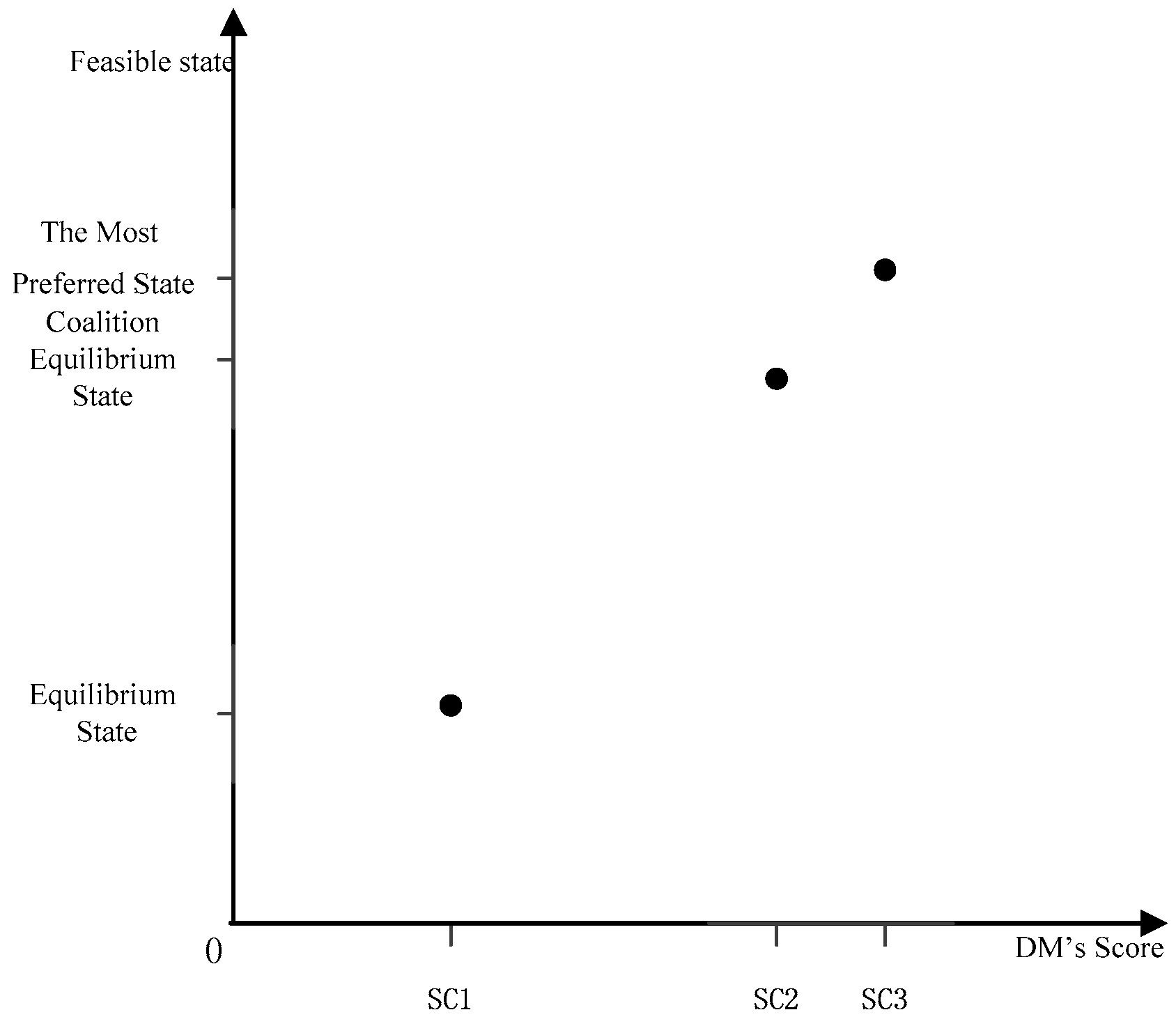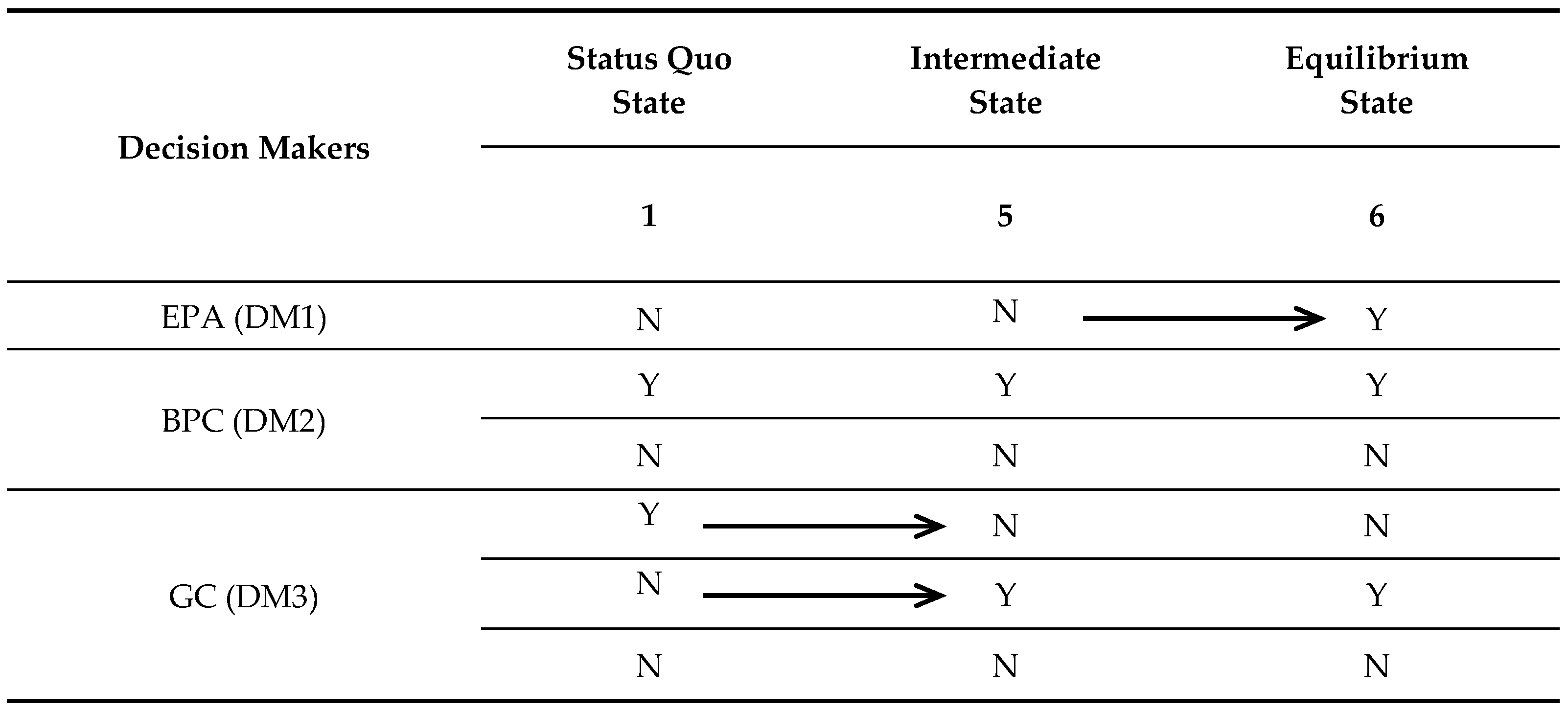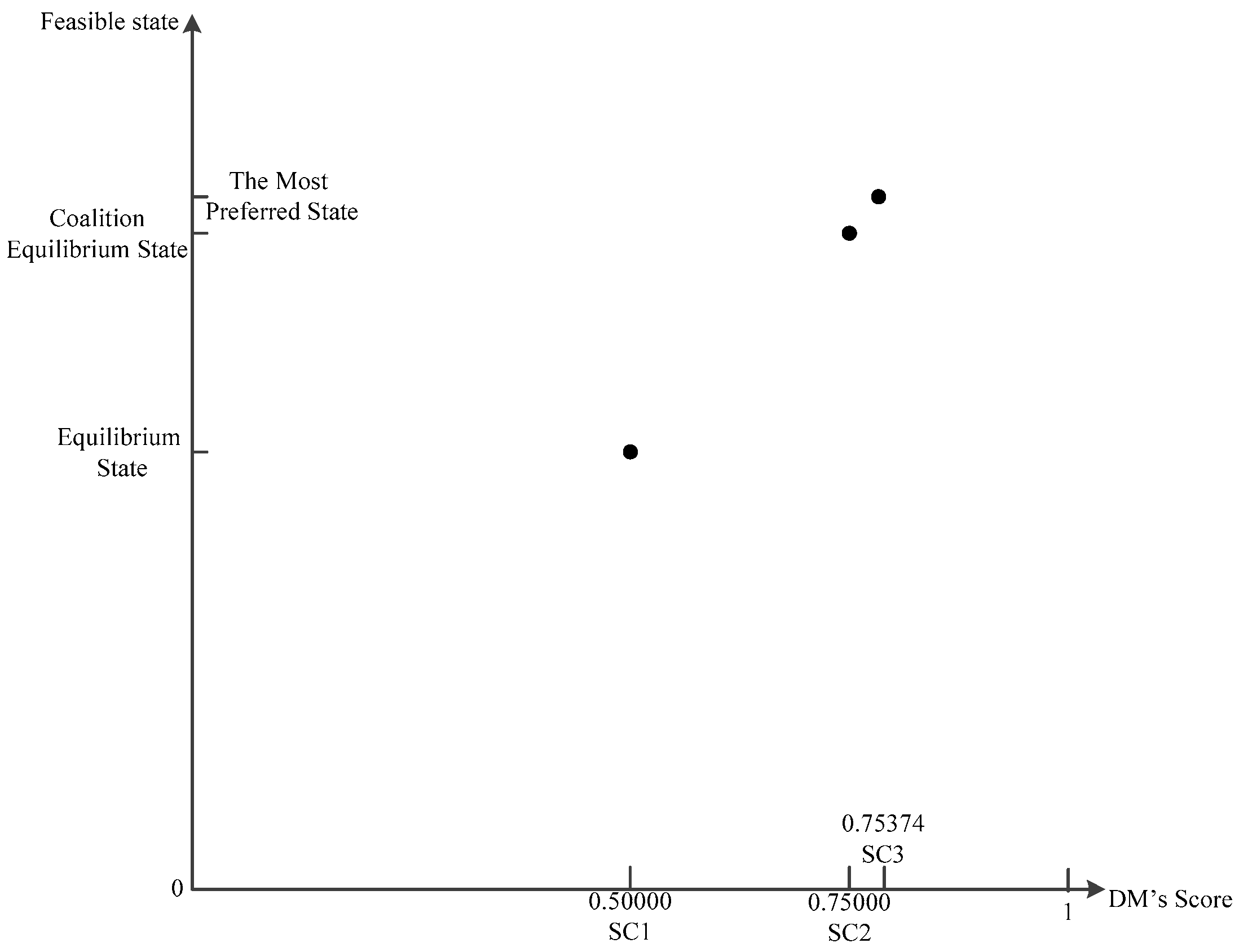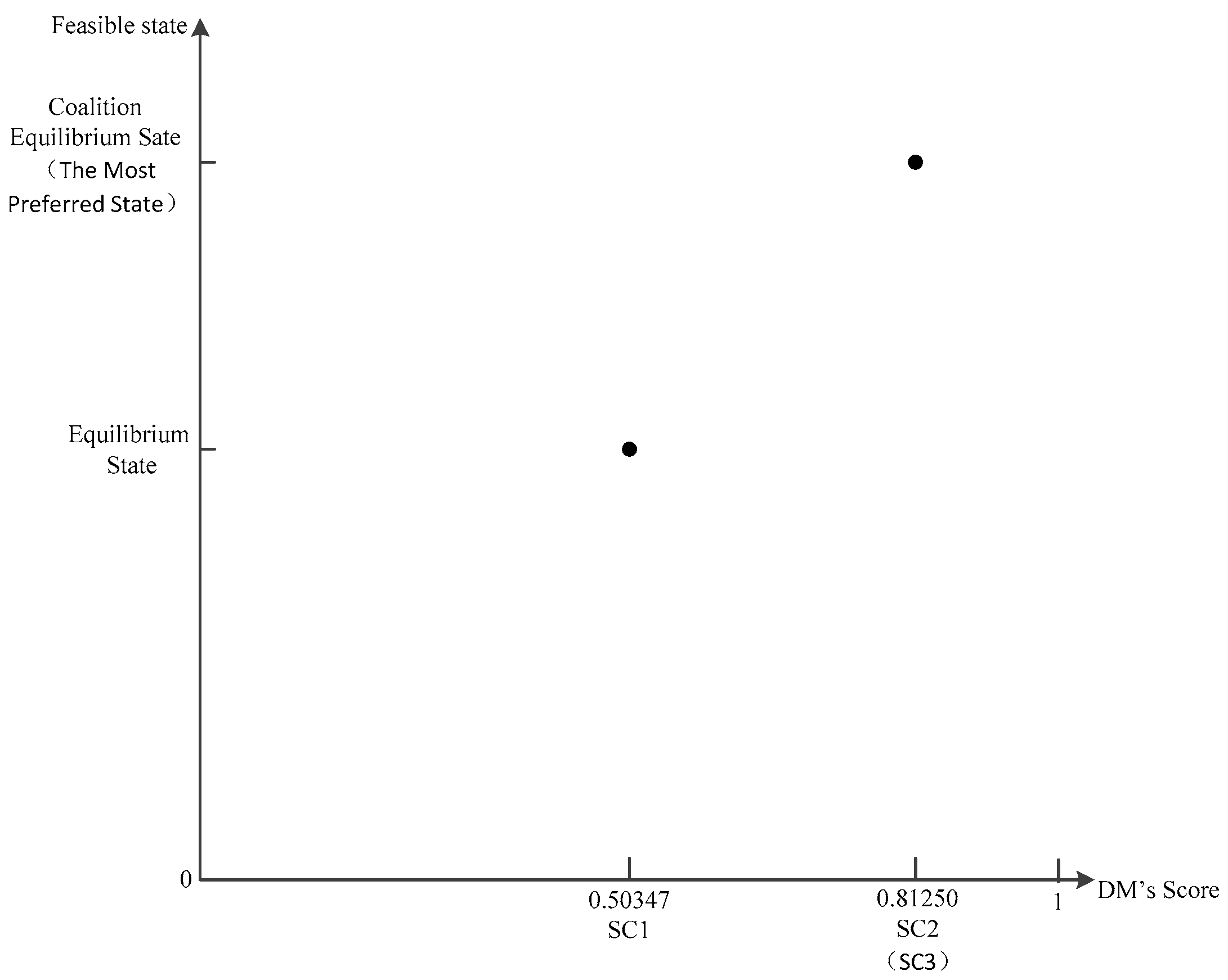The discussion outlined in the next subsection concerns the specified score function and real-coalition analysis. The score function is used for quantify a DM’s state preference within the GMCR. Subsequently, real-coalition analysis is defined to enhance the applicability of the graph model.
3.1. Score Function
Denote
as a DM’s level of confidence in its judgment of a preference statement. A higher value of
implies that the preference statement is more suitable for all states, while a lower value of
indicates that it is less appropriate:
There are preference statements in total; is the critical point in judging preference statements, and g is weight that decision maker consider the importance of the level of confidence. Form the first to -th preference statements, the DMs are fully confident in their judgments on preference statements. Starting from the ()-th preference statement, the certainty of the DMs’ judgment begins to weaken gradually.
Definition 1. Function (1) expresses DM confidence in the t-th preference statement and is the appointed confidence level function.
To further highlight the priority weights of preference statements, one important task is to value the preference statements. The priority of preference statements is defined as follow, according to the “preference tree” idea put forward by Hipel.
Definition 2. is defined to express the priority of preference statements. and .
Apparently, higher-priority preference statements are given greater weight, and lower-priority preference statements are given less weight.
In order to describe whether the state of DMi complies with individual preference statements.
Definition 3. For all ,
if conforms with preference statement ,
then ;
if does not meet the preference statement ,
then ,
which can be represented in Equation (2).
Definition 4. For all preference statements, score function is defined to characterize the DM’s score at a particular state ,
as shown in Equation (3) Score can be calculated for each feasible state for a particular DMi. The states can be ranked according to their scores; a state with a higher score is preferred to a state with a lower score, more specifically for if and only if .
3.2. Real-Coalition Analysis with Two DMs
On the basis of calculating the score for each feasible state for a particular DMi, the differences in coalition improvement can be captured. We can then compare the coalition motivation of each DM and judge the strength of coalition stability. In this research, we consider a coalition with two DMs temporarily.
In order to measure coalition motivation, a two-dimensional coordinate system needs to be established to describe the reforming. We represent the equilibrium state, the coalition equilibrium state, and the most preferred state in the coordinate system, as well as the corresponding score
of the three states. It is noticeable that the mapping relationship between states and scores is
f: x→y = x. As illustrated in
Figure 1, the horizontal axis means the score of DMs in different states, and the vertical axis represents states.
Definition 5. The degree of Collation Improvement, denoted by is given by Equation (4).
From the geometric meaning, the value of corresponds to the ratio of segment and segment . For DMi, when , the coalition equilibrium state’s score is located in middle between and . At this point, the improved degree is moderate. When , is closer to on the X axis, meaning that the coalition equilibrium state is closer to equilibrium state. In other words, the improved degree is not as good as expected. When , is closer to on the X axis, meaning that the coalition equilibrium state is closer to the most preferred state, i.e., the improved degree is more ideal. When , the coalition equilibrium state is equal to the most preferred state. This situation is the best result for coalition. In short, the degree of coalition improvement is positively correlated with the value of .
Definition 6. For any subset , and , if state s in are those that can be attained from s by a move by a member of H, or by a sequence of moves by members of H, then members of H are defined as a coalition.
Definition 7. A state s is coalition stable if and only if it is stable for all coalitions .
For DMs, the motivated coalition identifies that all members of coalition
prefer the target state to the status quo [
29]. So we have sufficient reason to weight the coalition motivation by a coalition member’s
that has been discussed above. Therefore, we can judge each DM’s willingness and accurately describe the tendency of coalition formation, namely which DM will be more active.
For , a DM with a higher corresponds to a stronger coalition motivation, that is, a greater willingness to form a coalition. In the process of forming a coalition, that DM will take the initiative to communicate and convey the desire of coalition formation or take corresponding strategies to facilitate coalition.
Next, we will discuss real-coalition stability. If equilibrium jumps exist, then the decision support system GMCR II will disseminate the outcome of coalition. However, in the real world, because of external circumstances as well as the opportunity cost in the practice of coalition, DMs may not be successful in forming a coalition. Even if the DMs can form a coalition, the interference of external circumstances and non-coalition DMs or outsiders will possibly lead to the breakup of the coalition relationship. In this section, we attempt to construct a paradigm based on the value of to measure the possibility of coalition and the coalition relationship stability, and to make GMCR more in line with the real world and have practical significance. The possibility and coalition relationship stability that consider the external environment and the opportunity cost are defined as real-coalition stability.
If the values of for both coalition decisions are less than 1, i.e., and , then the improvement degree is not good. Hence, in the process of coalescing, the two sides will conduct consultations and negotiations many times with high opportunity costs, thus sharply reducing the possibility of forming a coalition. Moreover, this situation can easily lead to coalition relations rupturing or a coalition being unable to evolve because of the obstruction of external circumstances and the temptation of interests by non-coalition DMs or other outsiders. Thus, the coalition relationship will break up effortlessly; hence, the real-coalition stability is poor.
Now suppose that the values of for both coalition decisions are greater than 1, i.e., and In that case, the real-coalition stability is steady and the degree of improvement is very significant. Hence, both sides have a strong will to coalesce, and the coalition status will not be interrupted by external conditions or other outsiders. In other words, the coalition relationship is tight. If the value of one of two co-DMs is less than 1 or both are equal to 1, the real-coalition stability is moderate.













